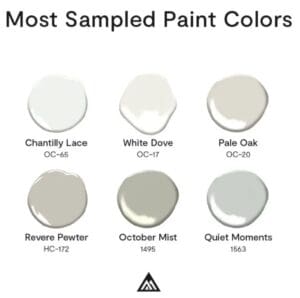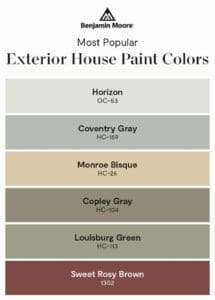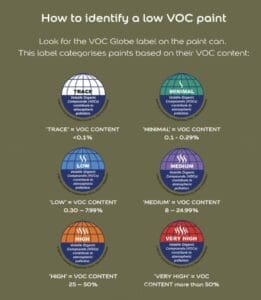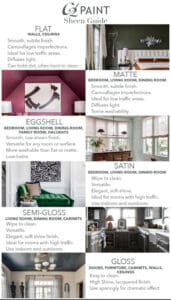FAQ
House Painting Questions & Answers
What are the most popular house paint colors right now?
Current popular colors include warm whites, soft grays, sage green, deep navy, and muted earth tones. These shades work well with a variety of home styles and landscapes.
Below are two links to blog posts that provide the latest color information.

Benjamin Moore Most Sampled Colors. All Los Angeles Painting Company, Inc.

Benjamin Moore Most Popular Exterior Colors. All Los Angeles Painting Company, Inc.
https://alllosangelespaintingcompany.com/2024/01/most-popular-paint-colors/
https://alllosangelespaintingcompany.com/2025/01/2025-house-paint-color-trends/
Why does All Los Angeles Painting Company, Inc. provide the best customer experience?
Consumers consider All Los Angeles Painting Company, Inc. the best house painter based on their high quality work, attention to detail, experience, product knowledge, excellent communication skills and superior customer service.
Is the quality of low VOC paint the same as regular conventional paint?
Generally yes. The quality of low VOC paints has greatly improved in recent years. Feel free to use a low VOC paint and expect the same quality as conventional paints.
Is there a difference between low VOC paints, Zero VOC paints, and natural paints?
Yes. Many low VOC and no VOC paints can and still contain synthetic chemicals. Natural paints claim to be made from only naturally occurring materials. Homeowners have been satisfied with both types. If one has a sensitivity to paint odors or chemicals, it is best to research the various brands of paint and make one's own informed decision before using them in your house.

Dulux Paint and VOC Guide. All Los Angeles Painting Company, Inc.
Is it important to hire a licensed, insured painting contractor?
Yes. All contractors are required to be licensed in California through the Contractor's State License Board (CSLB). To verify that a person claiming to be a contractor is licensed, ask to see his state issued license and personal identification to make sure you are dealing with the individual named on the contractor's license. All contractors are required to carry their contractor's license with them.
According to CSLB Registrar, Steve Sands, "Homeowners need to be fully aware of who they are letting into their homes...[and] the importance of spending a couple of minutes on CSLB's website to check the license before you hire a contractor to ensure you aren't putting your family or your home at risk."
Licensed California painting contractors must have at least four years of journey-level painting experience in their license classification and must pass exams demonstrating extensive knowledge of the painting trade and California contracting laws.
A licensed contractor must carry workers compensation insurance to shield homeowners from liability and have a contractor's license bond for consumer protection (generally stated as "bonded") If there is ever a problem with work done by any licensed contractor, their work is regulated by the CSLB and they will help you get satisfaction. The CSLB protects consumers by licensing and regulating California contractors.
Unlicensed painters are unregulated, uninsured, and often unaware of the latest paint products and developments. According to CSLB Register Steve Sands, "People put themselves and family members at risk when they hire unlicensed and uninsured individuals who can end up doing substandard work or never finish the job."
To verify a contractor's license is valid, go to www.cslb.ca.gov. To prove that a contractor carries insurance, request policy certificates from the contractor's insurance carrier.
What is the best paint finish to use in kitchens, bathrooms and other high moisture rooms?
High moisture rooms like kitchens, bathrooms and laundry rooms wear better with enamel paints. Once completely cured, (30 days) enamels are more moisture and humidity resistant, dirt resistant, washable, and scrubbable than flat paints.
Does paint have an expiration date?
According to the paint manufacturers, when stored properly, an unopened can of paint has a shelf life of one to two years. Once a can of paint has been opened, store it in a cool, dry place. If you want to use it again, check the paint to see if it is mold free and don't use it if smells bad. If it has gone bad, take it to a state regulated paint recycling center and dispose of it there.
What is elastomeric paint?
Elastomeric paint is a type of exterior coating used to protect against cracks, usually on smooth stucco or cement. Elastomeric paints have a stretch coefficient of 1/8" and have waterproofing and crack bridging properties that conventional exterior house paints don't have. Most manufacturers sell elastomeric paints and they can be tinted to almost any color. Elastomeric paint must to be applied to a thickness of at least 16-20 mils dry to qualify for a manufacturer's warranty.
What does paint finish, gloss level, sheen or enamel mean?
Paint finish, gloss level, sheen and enamel are all similar ways of saying the same thing. These describe the smoothness and light reflectivity of the dry paint on a painted surface. There are approximately six sheen types and each has a name corresponding to its light reflective qualities. Sheens range from:
- flat or matte (no-gloss)
- eggshell
- satin finish
- low lustre
- semi-gloss
- high-gloss
Each sheen has different qualities and uses. For example, a flat paint is often used to give a room a velvety look or to cover uneven drywall or plaster. A semi-gloss finish is often used in bathrooms and kitchens since it is cleanable and has a strong, hard shine. Generally, the higher the sheen the easier the paint is to clean and maintain.
Traditionally, dry room walls and ceilings are painted in flat or eggshell and trim is painted in semi-gloss enamel. Wet rooms such as kitchens, bathrooms, and laundry rooms are painted in semi-gloss. In Los Angeles, water-based finishes are the standard paints for interior and exterior painting.
Here is a C2 Paint Sheen Chart that describes where to apply each sheen:

C2 Paint Sheen Chart. All Los Angeles Painting Company, Inc.
How does one choose the right house painter?
A lot goes into choosing the right house painter. Click this link for advice: Selecting the right house painter. www.allabouthousepainting.com
What is the difference between spray and "brush & roll" when it comes to paint application.
Spraying and "brush & roll" are both acceptable ways to apply paint as long as the paint is put on at the proper spread rate (sq. ft./gallon). Spraying will provide a smoother appearance but is difficult to touch up. Brushing and rolling paint doesn't give as smooth an appearance as spraying, but is easier to touch up. Some people say that sprayed paint will not adhere as well as brushed & rolled paint but, if the surface is totally clean, both methods will adhere properly. Peeling problems can arise when sprayed paint is applied to a partially cleaned or dirty wall or surface. Depending on the surface to be painted and the condition and location it is in, a quality paint applicator will decide whether a spray or brush & rolled application technique is the best choice for the project.
I have old paint cans at my house, how do I dispose of them?
Don't throw your paint in the trash. Go to the lacsd.org web site to find a list of Household Hazardous Waste (HHW) collection sites. Los Angeles City operates six collection centers that are available to all County residents. This service is free and they accept your old paint. Check hours of operation for each site because they are only open certain days a week for a few hours each day.
Why do doors painted with latex paint sometimes stick to the weather-stripping?
Latex paints contain chemicals called plasticizers that assist in proper film formation and keep the coating flexible. Many vinyl and plastic weather-stripping materials also contain plasticizers to make them flexible. When the two surfaces come in contact with each other, they have a tendency to stick to each other. This condition, known as blocking, generally occurs during the early curing time of the coating, but it can continue for some time. Blocking can also occur on, interior doors, cabinets, double-hung windows and garage doors. The easiest way to prevent blocking is to use a non-blocking acrylic paint.
Do colors influence the perception of a room's size?
Lighter colors create the illusion of spaciousness and luminosity, while darker hues have the opposite effect. Consider this: if you paint the ceiling with a darker color than the walls, it will appear lower, diminishing the perceived height of the space.
How long does it take for latex paint to dry between coats?
Most latex paints when applied at temperatures between 60 and 90 degrees will be dry to the touch in about one hour and can be recoated within four hours. Various factors can increase these times such as poor ventilation, low temperatures, thick films and high humidity. In general one can safely put on two coats of water based paint in a day.
Which is better oil or water based house paint?
This used to be a big question. Good quality water-based or latex paint is the way to go to for residential painting. However, in a very few instances, it may be better to use an oil or alkyd-based paint. Here a list of the strengths and weaknesses of latex paint from the Paint Quality Institute:
Latex Paints
Quality interior latex paints provide better long-term flexibility, and resistance to cracking and chipping. Latex paints emit fewer odors, clean up with water and are not flammable. Latex paint takes a shorter amount of time to dry than oil paint.
Pros
- Low odor
- Faster dry time
- Water clean-up
- Long-term flexibility
- Non-yellowing
- Not combustible
Cons
- Relatively little amount of time paint can be brushed before it begins to set up.
Can I use interior paints on my exterior? Or use exterior paints on my interior?
The answer is no. It is not recommend to use an interior-labeled paint on exterior surfaces. Interior paints are designed specifically for use on interior surfaces. Interior paints don't have the flexibility, strength or UV protective elements to stand up to exterior conditions. If you use interior paint on your exterior, expect it to fail, get moldy, or peel quickly.
Do not use exterior paints for interior painting. Exterior paints have flex and other chemical qualities that make them suitable for exterior use only. Exterior paints are engineered to flex with heat and cooling of temperature changes. They don't get to do this on interiors and will crack and peel prematurely.
Use interior paints on interiors and use exterior paints for exteriors. There is a good reason why paints are labeled for interior or exterior use.
What is the best color to paint a guest room?
It's best to paint guest rooms a light neutral color. Light neutrals have a wide appeal and will make everyone feel at home.
If a front door is painted an impact color, should the back door be painted to match?
Usually only the main entrance door is painted an accent/impact color. All other doors should match the siding or trim. For instance, on a gray house with white trim and an orange front door, all other doors should be white.
Can vinyl and aluminum siding be painted?
Yes. Just like any other exterior painted surface, vinyl and aluminum siding require maintenance and repainting. Benefits to repainting include:
- Restoring weathered or faded siding to a finish similar to original factory condition.
2. Changing the home's color scheme.
3. Protecting the siding with a quality paint product.
Why Prime?
The success of any paint job depends on a properly prepared surface. Some surfaces require priming others don't. Since items being painted vary in porosity, gloss level and texture, priming can help provide an even and uniform surface for finish coats of paint.
How do I clean a freshly painted surface?
To assure maximum washability and durability, avoid touching, wiping, or cleaning painted surfaces for 30 days. It takes approximately one month for a painted surface to cure. After that time, dirt may be removed with a mild, non abrasive cleaner and water.
Can mildew be permanently avoided?
Unfortunately, no. Mildew is an airborne fungus that is able to grow on most surfaces, including painted ones. It can be black, brown, gray or green, and looks like dirt. Mildew will grow in any area that is dark and moist with limited air movement. While washing is a safe and effective way to remove mildew, it tends to reappear. Regular surface cleaning is one way to minimize mildew regrowth.
Are some colors more difficult in terms of coverage?
When it comes to paint coverage, not all colors are equal. Bright, clean yellows, oranges and reds often require special primers and multiple coats to provide full coverage.
What usually causes a paint coating to fail?
A paint coating can fail due to moisture, poor surface preparation, low-quality paint, incompatible paint, incorrect application, or exposure to the elements. These factors can cause issues such as peeling, cracking, chalking, or fading of the paint. Proper surface preparation, use of high-quality paint, correct application techniques, and protecting surfaces from moisture and the elements help ensure a long-lasting and durable paint job.
How do I choose a paint color?
There are two ways to choose paint colors.
First, hire a color consultant. https://allabouthousepainting.com/los-angeles-color-consult
Or, discover tips, inspiration and information here:
https://alllosangelespaintingcompany.com/category/los-angeles-color-inspiration/
What is the difference between paint color chips and sample boards?
Paint chips are small color cards from the store, while sample boards are larger painted sections created to see how the actual paint looks on the wall surface before buying the paint.